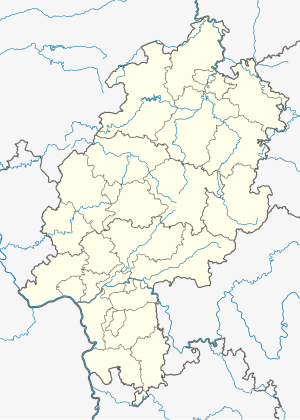Rudersdorf Tunnel
| Rudersdorf Tunnel | ||
|---|---|---|
| use | Railway tunnel | |
| traffic connection | Dill route (double track) | |
| place | Tiefenrother height | |
| length | 2652 m | |
| Number of tubes | 1 | |
| cross-section | horseshoe-shaped | |
| construction | ||
| Client | Prussian State Railway | |
| completion | 1915 | |
| business | ||
| operator | DB network | |
| location | ||
|
|
||
| Coordinates | ||
| South portal | 50 ° 48 ′ 42 " N , 8 ° 11 ′ 23" E | |
| North portal | 50 ° 49 ′ 35 " N , 8 ° 9 ′ 36" E | |
The Rudersdorfer Tunnel is a 2652 m long railway tunnel on the Dill line between the Siegen and Haiger stations . As the main engineering structure on the northern section of this railway line, it penetrates the Tiefenrother Höhe ( 552.3 m ), a mountain in the Rothaargebirge on the border between North Rhine-Westphalia and Hesse .
history
Due to the difficult topography and the limited technical possibilities, a direct connection between the train stations Siegen , Haiger and Dillenburg was not yet possible at the time of the construction of the Deutz-Gießener Bahn from today's Cologne-Deutz to Gießen in the 1850s. The direct connection between Siegen and Haiger was not completed until 1915. On July 2, 1915, work on the tunnel also ended. This was especially important for the coal traffic leading south from the Ruhr area . This shortened the route by around 30 km. The most elaborate engineering structure to create this connection was the Rudersdorf Tunnel. The originally planned four-track expansion of the line between Siegen and Dillenburg, which would have required a second tunnel, did not come about due to the First World War .
Technical parameters
The tunnel is 2652 m long, has two tracks and has been electrified since 1965 . It pierces the Tiefenrother Höhe ( 552.3 m ). The tunnel cross-section has a horseshoe-shaped profile with an average track spacing of 3.50 m.
In the longitudinal section, the tunnel runs in a roof profile. From the north portal at 371.75 m above sea level, the tunnel rises by 1.75 m to the first 753.9 m, and then on the rest of the way it falls by 18.25 m to 354.75 m above sea level at the south portal; Information in each case rail top edge. The highest overburden is 170.65 m.
The southern (Hessian) mouth of the tunnel is accompanied by two pilasters and has a natural stone cladding with the year 1915 as a building inscription . This facade is crowned by a gable . The current state of development of the tunnel allows a maximum speed of 110 km / h in both directions.
meaning
The border between North Rhine-Westphalia and Hesse runs inside the tunnel - at around 119.0 km. The Hessian part of the Rudersdorfer Tunnel is a cultural monument according to the Hessian Monument Protection Act .
future
Two new tunnel tubes are to be built west of the existing tunnel by 2031 and then the existing tunnel will be decommissioned and filled. The two new tunnels will each accommodate one directional track for the Dill route and will be approx. 400 meters longer than the current two-track tunnel. The two tubes should drop constantly from the north portal to the south portal.
In addition, it is planned to soften curves in the inlets on both sides of the tunnel in order to increase the speed between Rudersdorf and Haiger to at least 140 km / h.
The tender for the construction contract is imminent (as of June 2019).
literature
- State Office for Monument Preservation Hessen (Ed.): Railway in Hessen. Cultural monuments in Hessen. Monument topography Federal Republic of Germany . Vol. 2.2. Theiss Verlag, Stuttgart 2005. pp. 1011ff. ISBN 3-8062-1917-6
- Railway Atlas Germany (Edition 2009/2010). Schweers and Wall, Eupen 2009. ISBN 978-3-89494-139-0
Web links
- Rudersdorfer Tunnel , with information and pictures, on eisenbahntunnel-portal.de
Individual evidence
- ↑ a b Rudersdorfer Tunnel , with information and pictures, on eisenbahntunnel-portal.de
- ^ Scrolled back ... , Siegener Zeitung, July 30, 2011, p. 43
- ↑ a b c Dipl.-Ing. Ing.Jameleddine Torkhani, DB Engineering & Consulting GmbH, Cologne office: Rudersdorfer Tunnel: Basics for a sustainable solution . In: Tunnel (international specialist journal for underground construction, official organ of the STUVA ) . 2018, No. 6, November 2018. ISSN 0722-6241 . Retrieved on December 29, 2019. “The 100-year-old, double-track Rudersdorf Tunnel between Siegen and Haiger limits the performance of the line due to its small cross-section. In addition, the rail tunnel requires constantly increasing maintenance costs. In just seven months of project work, a feasibility study with six variants and a more in-depth preliminary planning for the preferred variant 3b "New construction of 2 single-track tunnel tubes west of the existing tunnel with its decommissioning" were drawn up. This has passed the "stress test" of DB Netz AG. "
- ^ Railway in Hesse , p. 1015.
- ↑ [1] ; ausschreibung-deutschland.de, May 23, 2019.
